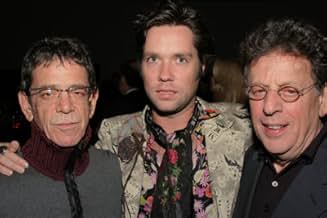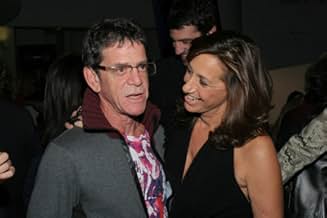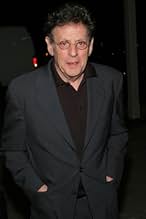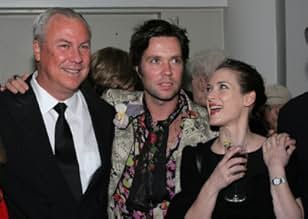From director, Katharina Otto-Bernstein, a provocative and moving documentary on the life and work of Robert Wilson, one of the most visionary and controversial theater artists of our time. ... Read allFrom director, Katharina Otto-Bernstein, a provocative and moving documentary on the life and work of Robert Wilson, one of the most visionary and controversial theater artists of our time. The film delivers a surprisingly candid look at Robert Wilson, who drops his characteristi... Read allFrom director, Katharina Otto-Bernstein, a provocative and moving documentary on the life and work of Robert Wilson, one of the most visionary and controversial theater artists of our time. The film delivers a surprisingly candid look at Robert Wilson, who drops his characteristic reticence and speaks with unprecedented candor about his personal life. Nothing is left ... Read all
- Director
- Writer
- Stars
- Awards
- 1 nomination total
- Self
- (archive footage)
- Director
- Writer
- All cast & crew
- Production, box office & more at IMDbPro
Featured reviews
As a highly prolific collaborator with some of America's most notorious underground icons like Philip Glass, Tom Waits or William S. Burroughs, Wilson managed to awe the theater world abroad with spectacles that lasted sometimes as long as a full week. His innovative choreography and completely new approach of visual story telling drew a huge following from places as unlikely as Iran and as far away as Australia. The home front however, stayed surprisingly quiet with respect to commercial success or celebrity although his following is substantial within the scene. Hailed by Europeans as a creative powerhouse for decades now, it comes as no surprise that a German filmmaker took on the task to chronicle Wilson's life and works.
Writer / director Katharina Otto follows the path of young Wilson from his conservative upbringing in Waco, TX, the restricted childhood and family life to his creative evolution and impact on the art scene of his days. Through original footage of his productions inter-cut with interviews of many of his contemporaries and Wilson himself, the composition awakes curiosity even if experimental theater is not your cup of tea. Robert Wilson is fascinating as a human being not just as an artist, reaching way beyond his expected platform.
Otto's documentary is a well orchestrated package with a refined appeal, allowing the viewer to completely focus on the subject as a man rather than an icon. Everything from camera, soundtrack to editing is flawless, highlighting the stark visions Wilson brought to the stage and his way of life. Educational, entertaining and often surprising; a piece of American Art History.
Berstein traces Wilson's life, beginning with his childhood, through the development of his artistic sensibilities against a backdrop of family, personal struggles, and social forces. Throughout the film, the juxtaposition of visual images from Wilson's life with scenes from his theatrical productions suggests that the artist drew much of his inspiration from his experiences with the world around him. While this method is not unusual, Wilson's approach to creating art is.
His productionsincluding such works as The Life and Times of Sigmund Freud, Death and Destruction in Detroit and Einstein on the Beachare visual tour de forces. Wilson emphasizes movement and light in favor of language. He communicates in symbols and gestures rather than traditional narrative form.
Berstein's film eloquently links Wilson's theatrical style to his personal relationship with language. Wilson stuttered as a child, a disability that exacerbated his status as a social outsider. In the film, he explains how he overcame this speech impediment with the help of a dancer, Byrd Hoffman, who taught him to slow down his thoughts and his movements when trying to speak. This moment, he claims, changed his entire perception of the worldand his work reflects this shift. Slow, deliberate movements take the place of realistic motion; speech occurs infrequently, often in abstraction.
The art of choreography enabled Wilson to deal with his own disability; since then, he has utilized this potential of art to help many disabled children. During a brief stint at architectural school, Wilson took a part-time job doing movement therapy with brain damaged children. He encourages expression through non-linguistic forms, and uses his theatrical work to illustrate the atypical thought processes of mentally and physically disabled individuals. Most famously, he adopted the deaf-mute child Raymond Andrews, with whom he collaborated to create the "silent opera" Deafman Glance. Similarly, he incorporated the texts of the autistic Christopher Knowles into the highly successful deconstructionist production A Letter to Queen Victoria.
In following with Wilson's preference for the visual over the linguistic, Berstein's film does its best to show us the correlations between the artist's personality and philosophy, his philosophy and his work (both theatrical and social). An impressive amount of stock footage constitutes much of the film, from still photos to archival videos. Berstein's manipulation of these images often resembles a kind of collage, a form of communication that seems well-suited to Wilson's own artistic style.
As a documentary, however, "Absolute Wilson" requires the use of interviews to fully tell its story. Along with Wilson himself, Berstein builds her portrait of the artist from the input of a wide variety of peoplefamily members, actors, critics and friends. While the multi-faceted perspective this approach creates proves intriguing, the effect sometimes seems more superficial than revealing. Nonetheless, several of the interviews become quite compelling, particularly the one with Wilson's sister.
Overall, Bernstein's film is remarkable in its portrayal of art as a lifestyle. Issues of father-son relations and social ostracization underlie the story of Robert Wilson's life, but Bernstein reveals how Wilson's art provided an outlet for coming to terms with the difficulties of life as well as a means to improve it. As one commenter states, almost more than any other artist, Wilson has succeeded in creating his own world through his art. Indeed, "Absolute Wilson" ultimately proves that, for Wilson, art is absolute.
This review was first posted on www.cinemattraction.com.
Did you know
Details
- Release date
- Countries of origin
- Official sites
- Language
- Also known as
- Apsolutni Vilson
- Production companies
- See more company credits at IMDbPro
Box office
- Gross US & Canada
- $66,217
- Opening weekend US & Canada
- $6,879
- Oct 29, 2006
- Gross worldwide
- $98,730
- Runtime1 hour 45 minutes
- Color
- Sound mix
Contribute to this page













